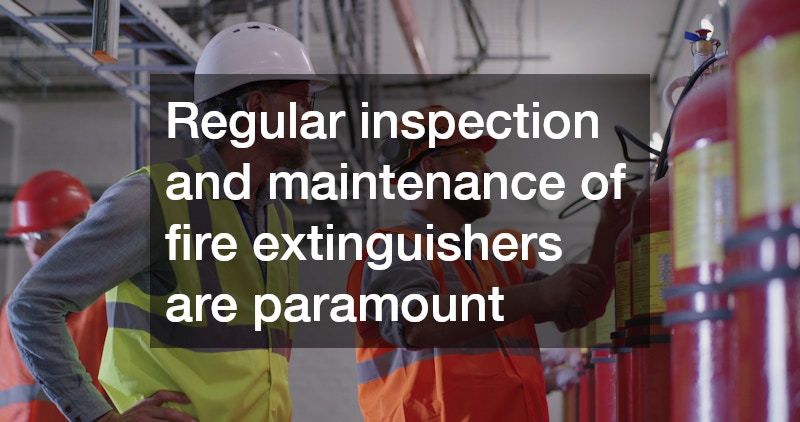Fire safety is a critical aspect of maintaining safe environments, both at home and in workplaces. A fire extinguisher sales and service company knows firsthand how important this is. Fire extinguishers play an essential role in emergency situations, providing a first line of defense against flames. Learn valuable tips and insights from professionals in the fire extinguisher sales and service industry to ensure that you are prepared in the face of potential fire hazards.
Understanding Fire Extinguishers
Fire extinguishers come in various types, each designed for specific classes of fires. Understanding the types of extinguishers is crucial in knowing which one to use in different situations and ensuring a safe response to fire incidents. The main categories of fire extinguishers include water, foam, dry powder, and CO2 extinguishers.
Water extinguishers are primarily used for Class A fires, which involve ordinary combustibles such as wood, paper, and textiles. They extinguish fires by cooling the burning material below its ignition temperature. On the other hand, foam extinguishers can tackle Class A and Class B fires, which are related to flammable liquids like gasoline or oils, by smothering the fire and preventing the vapors from igniting.
Dry powder extinguishers are versatile and can be used on Class A, B, and C fires, including electrical fires. They work by interrupting the chemical reaction of the fire. CO2 extinguishers are effective for Class B and electrical fires, as they displace oxygen and cool the flames. Knowing which type of extinguisher to use can make a significant difference in the outcome of fire emergencies.
Inspecting and Maintaining Extinguishers
Regular inspection and maintenance of fire extinguishers are paramount for ensuring their reliability during emergencies. According to fire safety regulations, all fire extinguishers should undergo monthly visual inspections to check for any obvious damage or signs of tampering. This routine check helps identify issues like a missing pin, gauge readings in the recharge zone, or physical damage.
In addition to monthly inspections, fire extinguishers should receive a professional maintenance check at least once a year. This annual service is crucial to ensure the internal mechanisms are functioning correctly and that the extinguisher has not lost pressure or integrity over time. A qualified technician will also ensure that the extinguishers are fully charged and that they conform to safety standards.
Failure to maintain fire extinguishers can lead to dire consequences during an emergency. An uninspected extinguisher may malfunction or fail to extinguish a fire, putting lives and property at risk. Therefore, establishing a routine for inspections and professional servicing is vital in maintaining fire safety readiness.
Using Extinguishers Properly
Using a fire extinguisher correctly can make the difference between a manageable situation and a full-blown emergency. The PASS technique is a simple yet effective method to remember the steps necessary for proper usage: Pull, Aim, Squeeze, Sweep. Each step is crucial for achieving optimal results when confronting a fire.
The first step, “Pull,” involves removing the safety pin from the top of the extinguisher. This pin prevents accidental discharge, and pulling it allows you to engage the extinguisher. Next, “Aim” requires you to point the nozzle at the base of the fire, not the flames. This is a critical point as aiming at the flames may prove ineffective in extinguishing the actual source of the fire.
In the “Squeeze” phase, you will need to squeeze the handle slowly and evenly to discharge the fire retardant. Finally, the “Sweep” step involves sweeping the nozzle from side to side, covering the area of the fire until it is fully extinguished. Remember, keeping a safe distance while using the extinguisher is essential to protect yourself from flames and heat.
Installing Fire Extinguishers
The strategic placement of fire extinguishers within a building is crucial for ensuring accessibility during emergencies. Extinguishers should be installed on every floor of a building, with particular attention given to high-risk areas such as kitchens, workshops, and near exits. This accessibility will minimize the time taken to reach an extinguisher in case of a fire.
According to fire safety codes, extinguishers should be mounted on walls at a height of about 3 to 5 feet, ensuring they are visible and easy to access. They must be placed away from potential fire hazards, such as near cooking appliances or heating sources. Additionally, clear signage indicating the location of extinguishers helps occupants know where to find them in an emergency.
Regularly assessing and updating extinguisher placements following renovations or a change in occupancy can further ensure that the safety measures remain effective. Training staff and occupants on where extinguishers are located and how to use them is also an important part of fire safety preparedness in any building.
Fire safety is an essential aspect of protecting lives and property. By understanding the different types of fire extinguishers, the importance of regular inspections, using extinguishers correctly, and their optimal placement, individuals can significantly enhance their fire safety awareness. By incorporating these tips into your safety protocol, you ensure a higher degree of preparedness in facing fire hazards, thereby fostering a safer environment for everyone.

